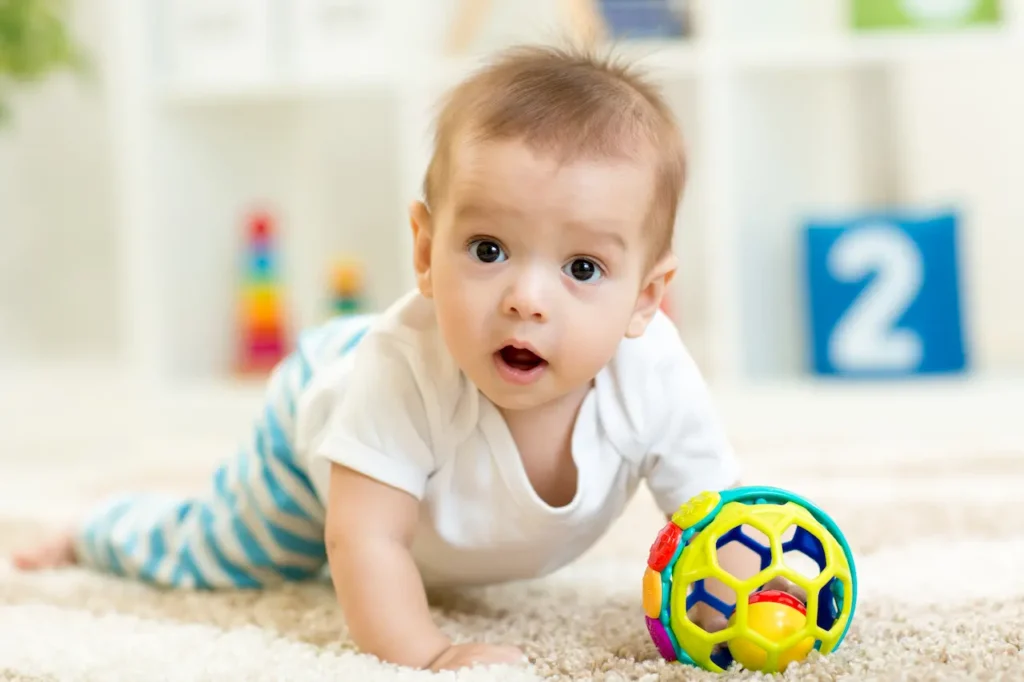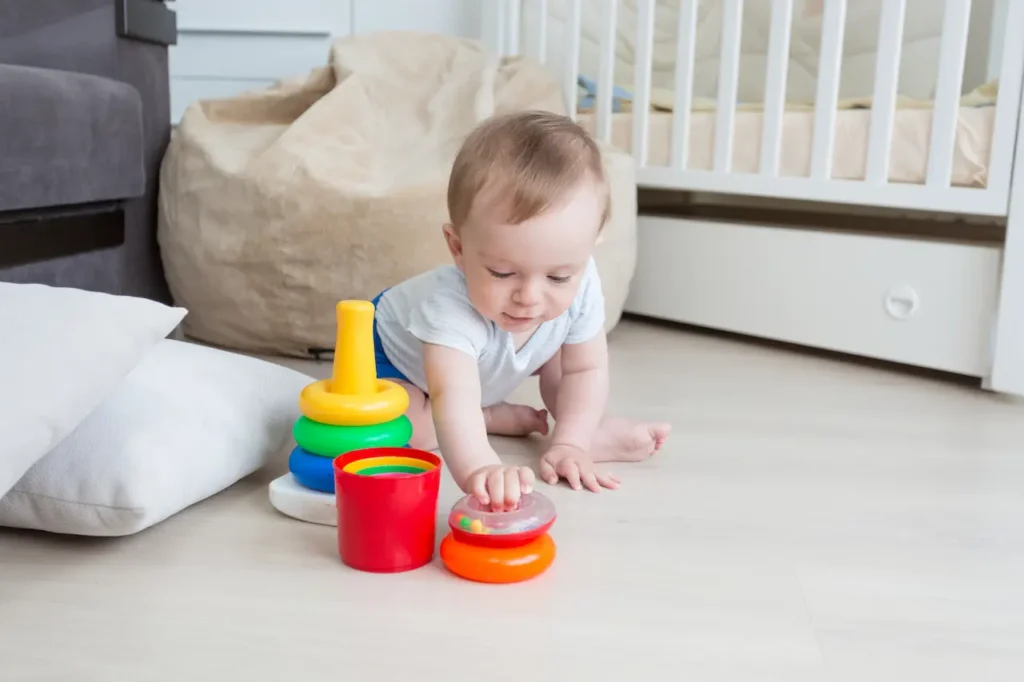It allows your baby to explore their environment and interact while also developing essential skills. It’s never too early to encourage your baby to crawl, even if they are still at the beginning stages of tummy time It’s worth revisiting crawling even if your child has moved on to walking. The physical, emotional, and mental benefits are still there. We’ll discuss the benefits of crawling games to boost a baby’s brain and offer some fun games that will encourage your child to crawl more.
Crawling is Beneficial for The Development
The development of your child’s brain, motor skills, and coordination will improve as they crawl. This will lay the foundation for their future cognitive and physical milestones.
1. Enhancing Physical Abilities
Crawling will be one of your baby’s first exercises. Crawling is the best way to strengthen the muscles that are used for walking, standing up, running, and jumping. While your baby is crawling, they are using their hands and arms in a coordinated way. It helps develop gross motor skills, which are important for body control and movement. Crawling helps babies develop strength in their upper and lower bodies, which will help them later with tasks such as standing, walking, and running.

Crawling is also important for the development of fine motor skills. As they crawl, babies develop their hand-eye coordination by reaching out their hands and exploring their surroundings. The fine motor skills of the baby are improved as they learn to grab objects and move them between their hands. Crawling also helps with balance as babies constantly adjust their body positions to avoid falling over.
Crawling improves your baby’s motor control. This improved coordination is important for learning to walk, throw a football, or ride a bicycle.
2. Encourage Cognitive Growth
Crawling is important for the development of cognitive abilities. As babies learn to crawl, their spatial awareness begins to develop. As babies crawl, they start to develop spatial awareness. While crawling, babies learn to judge distances and avoid obstacles. They also track moving objects. If your baby crawls towards a toy, for example, they will learn to calculate distances and adjust their movements accordingly.
Problem-solving skills are also enhanced by crawling. Your baby will learn to overcome obstacles as they crawl. You may need to crawl around a chair or under a table to get to your destination. These moments of problem-solving are crucial for their cognitive development, as they involve the brain in complex reasoning, decision-making, and planning.
Crawling also stimulates the development of both sides of the brain. Cross-lateral movements are used by babies when they crawl. The left hand and the right knee (or left hand and the right knee) move in tandem. This improves cognitive abilities such as memory, attention and critical thinking.
3. Enhancing Visual Skills
It’s not just important for your baby’s cognitive and physical growth, but it’s also essential for their visual development. While crawling, babies shift their attention between objects close to them and those farther away, working their eye muscles. It helps them develop their ability to track moving items, adjust their focus, and judge distances. All of these skills are important for later activities, such as reading, sports, and driving a vehicle. Crawling improves visual coordination and depth perception, both of which are vital to future abilities.
Crawling also helps babies to engage in bilateral activities where they must visually track moving objects. The ability to refocus between near and far objects will be a skill they use for the rest of their lives.
4. Supporting Cross-Lateral Integration
Cross-lateral integration is important to understand how crawling helps your baby’s development. As babies crawl, opposite sides of the body are coordinated, such as when they move their right hand and left leg simultaneously. Communication between the left and right hemispheres is required. The right hemisphere is responsible for controlling the left side of the body, and the left hemisphere is responsible for the right. Crawling helps to establish communication between the hemispheres by engaging both at once.
This integration can have a profound impact on the cognitive and motor development of a child. Cross-lateral integration is important for language development, problem-solving, memory, and emotional regulation. Many experts believe that crawling can be essential to the development of skills like reading and writing because it improves communication between the left side and the right side of the brain.

Playing Games that Encourage Crawling
It doesn’t need to be boring or difficult for your child to crawl. Crawling can be an engaging and fun activity that promotes their physical and cognitive growth. Here are some fun crawling games that will encourage your baby and strengthen your bond with your child.
1. Toys to Chase
Toys are one of the easiest and most effective methods to encourage crawling. Toys that move or make noise are particularly attractive to babies. Rolling ssoftballswith bells in them on the ground will encourage your baby to chase them. Encourage your baby to reach out and grab the ball as it rolls. To encourage your baby to crawl towards the toys, you can use toys like push-along cars and animals that move when pushed or toys that roll. Praise their achievements to keep them motivated.
2. Build a Tunnel
A crawling tunnel is a fun challenge for your child. A cardboard box that has both ends opened can be used to create a crawling tunnel, or you can buy a collapsible baby fabric tunnel. The excitement of crawling in a tunnel can help your baby develop coordination. You can encourage your child to follow a ball or toy through the tunnel by rolling it. This will help them develop their gross motor skills and problem-solving abilities.
3. Explore Different Textures
You can encourage crawling by encouraging babies to explore new textures. Spread a variety of materials, like soft blankets or a rubbery mat, on the floor. You can also scrunch up paper. Allow your baby to crawl over these surfaces and discover what they feel like. This activity stimulates the brain by providing sensory stimulation. Different textures encourage your baby to move differently, which helps with motor coordination and stability.
4. Crawl Chasing
Playing crawl chasing is a great way to engage your baby on the floor. Crawl away from your baby on all fours and encourage them to follow you. This game is a great way to interact with others, and babies enjoy mimicking their parents’ actions. The physical movement and excitement keep your baby active and engaged. The chase strengthens your bond with your baby and fosters emotional development.
5. Pillow Obstacle Course
Pillow obstacle courses are another way to encourage crawling. Encourage your baby to crawl around or over pillows, cushions, or soft blankets. Pillows are soft and squishy, making it easy for your baby to navigate. The varying heights can also challenge their balance and coordination. Your baby will develop spatial awareness, body control, and coordination as they crawl over pillows.
6. Find the Toy Game
Try hiding your child’s favorite toy and encourage them to crawl towards it. To increase the challenge, you can either hide the toy under a towel or in plain view. Celebrate your baby’s success by praising them and showing excitement. This game encourages your baby to crawl and also teaches them the relationship between effort, reward, and success. This game also improves your baby’s cognitive skills as they begin to grasp the concept of “finding” and working towards a goal.
What If My Baby Doesn’t Crumble?
While it is normal for babies between the ages of 6-10 months to begin crawling, each baby will develop at his or her own pace. Some babies skip the crawling phase entirely and go straight from standing or sitting to walking. This is a perfectly normal variation in development and should not be feared. Remember that each baby is unique and may not crawl at the same time.
If your baby is still not crawling at 12 months old, you should consult with your pediatrician. It’s best to eliminate any developmental concerns, even if many babies are slow. Your pediatrician can assess your baby’s development and provide you with the peace of mind that you need. Early intervention can be very effective in addressing any concerns or delays.
There are many ways to help your baby develop their mobility and coordination, even if they haven’t started crawling. Tummy time is one of the best ways to help your baby develop the muscles necessary for crawling. This helps to develop the neck, shoulders, and back muscles, which can help lay the foundation for future physical development.

Conclusion
The crawling milestone is a developmental milestone for your baby that has benefits beyond physical movement. Crawling for your baby is not just a physical milestone, but it’s also an important step in developing their motor skills, their brain function, and their emotional growth. While your baby crawls around on all fours,s, they strengthen vital muscle groups and improve coordination. They also increase their physical strength. These benefits are essential in developing the skills necessary for later physical activities such as walking and running. Crawling is not just a great way to work out your body; it also helps develop the brain. Cross-lateral integration is a process that has been proven to promote neural connections in both the left and the right hemispheres of the brain. This connection enhances cognitive functions such as problem-solving, memory, and language development.
Crawling helps your baby develop important body control and self-confidence. They gain a greater sense of self-confidence as they master their movements and learn how to move from place to place. As your baby begins to learn about their environment, they will also develop spatial awareness. This spatial awareness will help your child develop a range of skills in later life, such as reading and math.
Playing engaging and fun games will encourage your baby to crawl. These games will stimulate their physical as well as cognitive development. This will encourage your baby to feel confident and accomplished. Simple games, such as crawling towards a toy that is colorful or playing “chase” with a member of your family, can encourage your child to crawl. These moments not only benefit your baby’s physical and cognitive development, but they also allow you to create lasting memories and bond with them. Each laugh, each time your child achieves a goal, and every moment of joyful play will strengthen the bond between you and them, promoting their social and emotional development.



